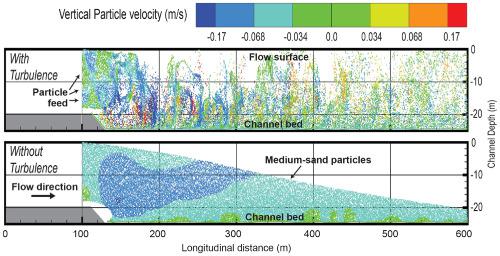当前位置:
X-MOL 学术
›
Earth Surf.Process. Land.
›
论文详情
Our official English website, www.x-mol.net, welcomes your
feedback! (Note: you will need to create a separate account there.)
Sand settling through bedform‐generated turbulence in rivers
Earth Surface Processes and Landforms ( IF 2.8 ) Pub Date : 2020-08-15 , DOI: 10.1002/esp.4962 Brendan Yuill 1 , Yushi Wang 1 , Mead Allison 2 , Ehab Meselhe 2 , Chris Esposito 1
Earth Surface Processes and Landforms ( IF 2.8 ) Pub Date : 2020-08-15 , DOI: 10.1002/esp.4962 Brendan Yuill 1 , Yushi Wang 1 , Mead Allison 2 , Ehab Meselhe 2 , Chris Esposito 1
Affiliation

|
Fluvial bedforms generate a turbulent wake that can impact suspended‐sediment settling in the passing flow. This impact has implications for local suspended‐sediment transport, bedform stability, and channel evolution; however, it is typically not well‐considered in geomorphologic models. Our study uses a three‐dimensional OpenFOAM hydrodynamic and particle‐tracking model to investigate how turbulence generated from bedforms and the channel bed influences medium sand‐sized particle settling, in terms of the distribution of suspended particles within the flow field and particle‐settling velocities. The model resolved the effect of an engineered bedform, which altered the flow field in a manner similar to a natural dune. The modelling scenarios alternated bed morphology and the simulation of turbulence, using detached eddy simulation (DES), to differentiate the influence of bedform‐generated turbulence relative to that of turbulence generated from the channel bed. The bedform generated a turbulent wake that was composed of eddies with significant anisotropic properties. The eddies and, to a lesser degree, turbulence arising from velocity shear at the bed substantially reduced settling velocities relative to the settling velocities predicted in the absence of turbulence. The eddies tended to advect sediment particles in their primary direction, diffuse particles throughout the flow column, and reduced settling likely due to production of a positively skewed vertical‐velocity fluctuation distribution. Study results suggest that the bedform wake has a significant impact on particle‐settling behaviour (up to a 50% reduction in settling velocity) at a scale capable of modulating local suspended transport rates and bedform dynamics. © 2020 John Wiley & Sons, Ltd.
中文翻译:

沙子通过河床形成的湍流沉降
河流床型会产生湍流尾流,影响悬浮沉积物在流过的水流中的沉降。这种影响对局部悬浮沉积物运输、床型稳定性和河道演化具有影响;然而,它在地貌模型中通常没有得到很好的考虑。我们的研究使用三维 OpenFOAM 流体动力学和粒子跟踪模型来研究床型和通道床产生的湍流如何影响中等砂粒大小的粒子沉降,就流场内悬浮粒子的分布和粒子沉降速度而言. 该模型解决了工程床型的影响,它以类似于天然沙丘的方式改变了流场。建模场景交替使用分离涡流模拟 (DES) 和湍流模拟,区分河床产生的湍流与河床产生的湍流的影响。床型产生了湍流尾流,该尾流由具有显着各向异性特性的涡流组成。与在没有湍流的情况下预测的沉降速度相比,涡流以及在较小程度上由床的速度剪切引起的湍流大大降低了沉降速度。涡流倾向于在其主要方向上平流沉积颗粒,将颗粒扩散到整个流柱中,并且可能由于产生正倾斜的垂直速度波动分布而减少沉降。研究结果表明,床型尾流在能够调节局部悬浮运输速率和床型动力学的尺度上对颗粒沉降行为(沉降速度降低高达 50%)有显着影响。© 2020 约翰威利父子公司
更新日期:2020-08-15
中文翻译:

沙子通过河床形成的湍流沉降
河流床型会产生湍流尾流,影响悬浮沉积物在流过的水流中的沉降。这种影响对局部悬浮沉积物运输、床型稳定性和河道演化具有影响;然而,它在地貌模型中通常没有得到很好的考虑。我们的研究使用三维 OpenFOAM 流体动力学和粒子跟踪模型来研究床型和通道床产生的湍流如何影响中等砂粒大小的粒子沉降,就流场内悬浮粒子的分布和粒子沉降速度而言. 该模型解决了工程床型的影响,它以类似于天然沙丘的方式改变了流场。建模场景交替使用分离涡流模拟 (DES) 和湍流模拟,区分河床产生的湍流与河床产生的湍流的影响。床型产生了湍流尾流,该尾流由具有显着各向异性特性的涡流组成。与在没有湍流的情况下预测的沉降速度相比,涡流以及在较小程度上由床的速度剪切引起的湍流大大降低了沉降速度。涡流倾向于在其主要方向上平流沉积颗粒,将颗粒扩散到整个流柱中,并且可能由于产生正倾斜的垂直速度波动分布而减少沉降。研究结果表明,床型尾流在能够调节局部悬浮运输速率和床型动力学的尺度上对颗粒沉降行为(沉降速度降低高达 50%)有显着影响。© 2020 约翰威利父子公司











































 京公网安备 11010802027423号
京公网安备 11010802027423号